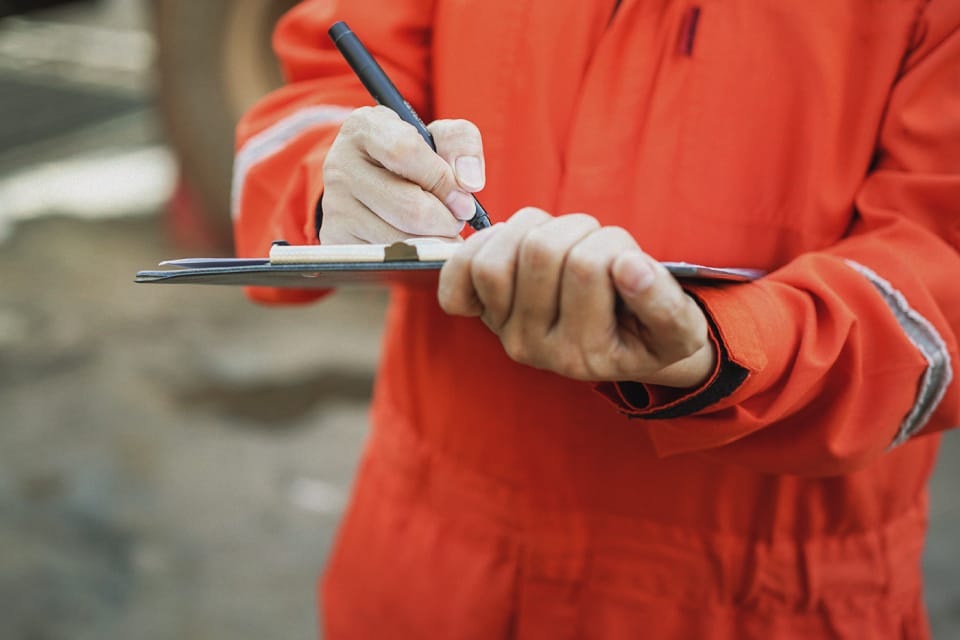
Mental Health Monitoring: Beyond the Checkboxes | Risk Matrix Episode 121
THE RISK MATRIX Cutting-edge podcast on occupational safety and risk management. Hosted by industry titans: JAMES JUNKIN, MS, CSP, MSP,…

When it comes to ensuring an airtight EHS strategy, having a safety officer on your team is crucial. Through their dedicated commitment to hazard control, risk mitigation, compliance, and ongoing training, safety officers play a key role in making sure your jobsite is safe for all workers.
The role of a safety officer can easily be confused with that of an EHS manager. Both are highly trained in safety and compliance, and they are passionate about fostering a strong safety culture at every level of the company. But there are some key differences. While an EHS manager oversees and implements policies, programs, and procedures, a safety officer is the glue that ensures safety procedures are understood, followed, and resonate with workers.
This article summarizes some of the most important responsibilities that fall on the shoulders of safety officers.
Safety officers play a key role in collaborating with management and various departments within a company. They work with employees to ensure that safety measures are integrated into all processes and decisions. They understand that safety must be built into the design phase of a project. Communication and stakeholder relations are crucial skills that safety officers rely on daily.
When it comes to compliance, the safety officer must remain on top of existing and emerging regulations and standards, ensuring that the company complies with safety protocols. This constant vigilance not only keeps workers safe but also protects the company against potential liabilities. The bottom line is rigorous compliance practices save companies money.
Proper and continuous risk mitigation leads to a safe and healthy work environment. But it’s a big job, which is why you need an expert to manage it. Safety officers are trained in risk mitigation, which is a skill set you need to invest in. They oversee and implement comprehensive strategies aimed at identifying, assessing, and reducing risks across all areas of your operations.
There are many aspects to mitigating risk including hazard assessments, but staying on top of potential hazards on the jobsite is no easy task. Safety officers systematically identify potential hazards, including physical (machinery, falls, etc.) and environmental (noise, chemical exposure etc.). Once they identify the hazards, they assess the level of risk of each by using various tools, checklists, and incident databases.
Your safety officer is your go-to training facilitator. With their close relationships with employees AND management, safety officers are in the perfect position to ensure training programs are at the highest standard. Workers need to be educated on safety protocols, hazard identification and prevention, safety equipment, as well as any specialized skills training they require. Safety officers also play a role in advocating for training sessions that may be missing from the overall safety program.
By providing ongoing training sessions and using innovative technology to meet workers “where they are”, safety officers empower your workforce to be proactive in maintaining a safe work environment.
Fostering a work environment with a solid safety culture is crucial in ensuring all employees at ALL levels put safety first. A safety officer plays a key role in maintaining a strong culture of safety by working with people at all levels of the organization and educating them on the importance of safety. They develop programs, campaigns, and incentives that promote a safety-first mindset among employees, making safety a core value, rather than a framed mission statement on a wall.
When things go wrong, the key is learning from the incident and implementing improvements to prevent similar accidents from happening again. This requires innovative and strategic thinking and planning on the part of the safety officer. They are required to work closely and collaboratively with the safety team, investigators, and management to determine the root cause of the incident and then put steps in place to prevent future mishaps.
Furthermore, the safety officer is called upon to seek new ways to enhance safety measures. They must continuously monitor trends and explore new technologies and practices to improve existing safety protocols.
A major incident or crisis not only threatens the safety of your workers, but also threatens your bottom line. That’s why having a designated leader in charge of emergencies is invaluable. That’s where your safety officer shines. They take charge, implementing well-rehearsed protocols and plans to manage and mitigate the impact of incidents. They coordinate responses, ensuring the safety and security of everyone involved.
Prioritizing safety is critical for any company, especially those with high-hazard worksites. The safety officer plays a key role as both a safety expert and advocate, creating a safer, more productive work environment that benefits everyone.
At Veriforce, we salute safety officers and the work they do every day to prevent incidents and keep workers safe. We offer comprehensive solutions to support their efforts by making their job easier and more efficient by streamlining compliance, training, and communication.
Contact us today to learn more.


THE RISK MATRIX Cutting-edge podcast on occupational safety and risk management. Hosted by industry titans: JAMES JUNKIN, MS, CSP, MSP,…
We’ll send you practical and insightful supply chain risk management info that can benefit your business. Plus, important company updates that keep you in the loop.
